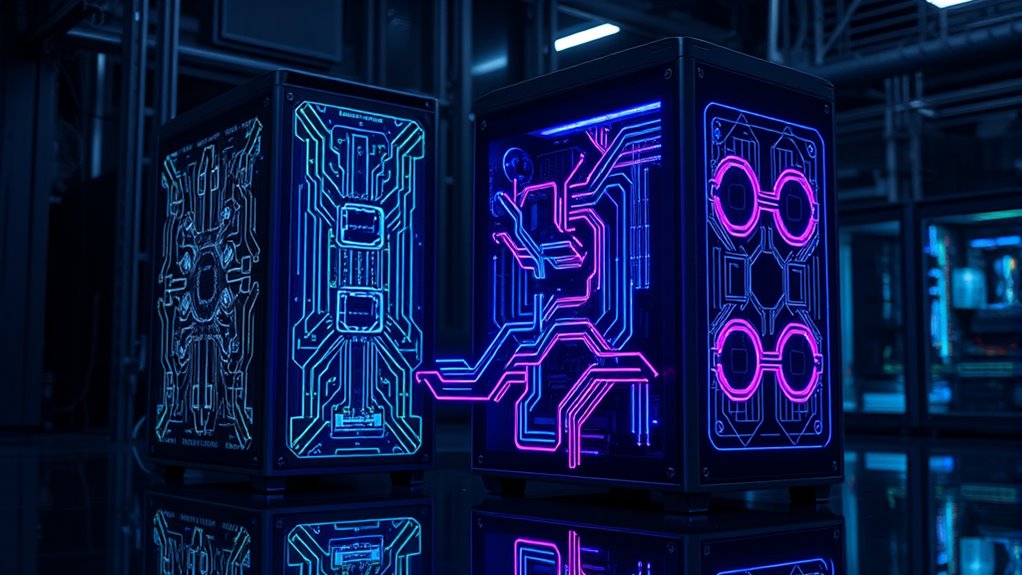Hybrid computing combines classical and quantum systems to boost processing power and solve complex problems more efficiently. You can assign routine tasks like data handling to traditional computers while leveraging quantum processors for optimization, factorization, or simulations. This integration requires careful protocols for data transfer and error correction. As you explore further, you’ll discover how this innovative approach is transforming industries and pushing technological boundaries beyond traditional limits.
Key Takeaways
- Hybrid computing integrates quantum processors with classical systems to enhance problem-solving efficiency.
- Tasks are divided based on system strengths, with classical handling large data and quantum tackling complex problems.
- Seamless communication, data transfer, and error correction protocols are essential for effective integration.
- This approach enables breakthroughs in cryptography, material science, and optimization problems.
- Future developments aim to improve system coordination, scalability, and expand computational capabilities.

Have you ever wondered how modern computing systems handle complex tasks more efficiently? The answer lies in hybrid computing, a powerful approach that combines the strengths of classical and quantum systems. By integrating quantum classical integration, developers can leverage the unique capabilities of quantum processors alongside traditional computers, creating more capable and versatile solutions. This approach isn’t just about adding a quantum component; it’s about designing systems that work seamlessly together, optimizing performance across a wide range of applications.
Hybrid computing combines classical and quantum systems for more efficient, versatile solutions.
One of the key aspects of hybrid computing is hybrid algorithm design. These algorithms are crafted to divide tasks intelligently between classical and quantum processors, ensuring each handles what it does best. Classical systems excel at managing large data, performing repetitive calculations, and executing well-understood algorithms. On the other hand, quantum processors are particularly suited for specific problems like optimization, factorization, and simulating quantum systems. When you design a hybrid algorithm, you’re fundamentally creating a workflow where the classical system handles the bulk of the work, while the quantum system tackles the parts that can benefit from quantum speedup. This division maximizes efficiency and reduces overall processing time.
Implementing quantum classical integration requires careful coordination. It involves developing protocols for data transfer, synchronization, and error correction, ensuring that quantum and classical components communicate effectively. You’ll need to contemplate how to encode data for quantum processing, manage the transfer of results back to classical systems, and handle the noise and decoherence that can affect quantum operations. Successful integration demands a deep understanding of both quantum mechanics and classical computing principles, making hybrid algorithm design a complex but rewarding challenge. Additionally, understanding Ford Tuning concepts helps in optimizing system performance by applying best practices from different technical fields.
This synergy opens up new possibilities for solving problems previously regarded as intractable. For example, in cryptography, hybrid systems can perform faster factorization, threatening current encryption methods but also enabling the development of more secure protocols. In material science, they simulate complex molecules more accurately, accelerating discoveries. As you work with hybrid systems, you start to see how combining quantum and classical computing isn’t just a technical upgrade; it’s a paradigm shift that can revolutionize industries.
Ultimately, hybrid computing guides you toward smarter, faster solutions. By blending quantum classical integration with innovative hybrid algorithm design, you create systems that adapt to the specific demands of each task. This integration not only improves efficiency but also pushes the boundaries of what’s possible, making hybrid computing a key player in the future of technology.
Frequently Asked Questions
How Do Classical and Quantum Systems Communicate Effectively?
You can make classical and quantum systems communicate effectively through a classical-quantum interface, which translates data between the two. Quantum entanglement helps synchronize states, enabling faster information transfer. You’ll need robust protocols to manage noise and decoherence, guaranteeing data integrity during exchange. By designing efficient interfaces and leveraging quantum entanglement, you guarantee seamless communication, combining quantum speed with classical reliability for ideal hybrid computing performance.
What Are the Primary Challenges in Integrating These Systems?
You face primary challenges like hardware integration and scalability issues when combining classical and quantum systems. Integrating different hardware architectures requires compatible interfaces and communication protocols, which can be complex. Scalability becomes a problem as quantum systems grow, since maintaining qubit coherence and error correction demands advanced techniques. Overcoming these hurdles involves developing robust hardware interfaces and scalable quantum architectures, ensuring smooth collaboration between classical and quantum components.
How Secure Are Hybrid Computing Environments?
They say “trust, but verify,” and it applies here. Your hybrid environment’s security depends on how well you implement quantum encryption and guarantee data synchronization. Quantum encryption offers strong protection, but vulnerabilities can arise if synchronization fails or if classical systems lag behind. Regular updates, robust protocols, and vigilant monitoring help keep your hybrid setup secure, making it as safe as possible in a rapidly evolving threat landscape.
What Industries Benefit Most From Hybrid Computing?
You’ll find industries like finance, pharmaceuticals, and logistics benefit most from hybrid computing. They leverage quantum algorithms to solve complex problems faster and more efficiently, enhancing industry applications such as drug discovery, financial modeling, and supply chain optimization. By combining classical and quantum systems, these sectors can address challenges previously deemed unsolvable, boosting innovation and competitiveness while streamlining operations and improving decision-making processes.
How Is Data Consistency Maintained Across Systems?
You maintain data consistency across systems through robust data synchronization techniques and strict consistency protocols. These protocols ensure changes made in one system are accurately reflected in the other, preventing discrepancies. Regular synchronization schedules and real-time updates help keep data aligned, while error detection mechanisms address inconsistencies promptly. By implementing these strategies, you guarantee seamless integration and reliable data transfer between classical and quantum components, maintaining integrity across the hybrid computing environment.
Conclusion
By combining classical and quantum systems, you create a powerful hybrid computing approach. Think of it like a team where each member handles what they do best—classical for everyday tasks, quantum for complex problems. This synergy accelerates innovation without replacing existing technology. So, don’t see it as replacing classical computing, but enhancing it—like adding a turbo boost to your car. Together, they open new horizons for solving the toughest challenges ahead.









